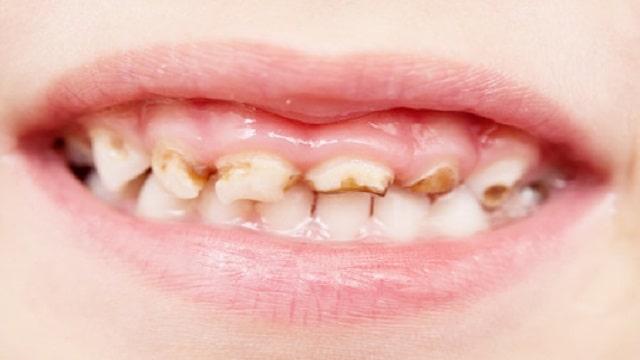
Baby Bottle Tooth Decay Symptoms, Risk Factors & Treatment | Diseases List A-Z
Baby Bottle Tooth Decay Taking care of teeth from an early age is very important, especially for babies and children.
This is because teeth are needed for their growth and development.
Teeth in babies or children are useful for chewing food.
In addition, teeth are also an important component for speaking.
Disorders in baby or child teeth can cause infections and pain that cause disorders in speech and eating development that can have an impact on low body weight and not being agile, unlike children in general.
The causes of disorders in baby and child teeth are various.
However, most cases of baby bottle tooth decay can be prevented.
Tooth decay or tooth decay in babies or young children is also called baby bottle tooth decay because it often occurs in babies or children who use pacifiers or baby bottles.
This disease occurs when there is a sweet liquid or one that contains sugar that sticks to the baby’s or child’s teeth for a long time.
The types of foods that contain sugar can vary, for example, milk, fruit juice, soda, leftover candy, or sweets.
This incident increases in babies or children who are given milk at bedtime, because during sleep the production of saliva decreases, so that the remaining sugar will stick to the teeth for a long time.
The sticking of these sugar residues stimulates bacteria in the mouth to multiply and produce acids that can damage teeth.
Usually, tooth decay occurs in the upper front teeth, but can also occur in other teeth.
Symptoms of Baby Bottle Tooth Decay The first sign of tooth decay is usually a white or yellowish spot or mark on the upper front teeth.
In the very early stages, this sign can usually only be seen by a dentist during a routine check-up.
If not treated and prevented further, this condition will become more severe and widespread which will cause symptoms: Baby or child teeth change color to yellowish, brown, or black.
Baby or child teeth appear shorter or smaller.
Swollen gums.
Teeth easily fall out or break.
The child becomes difficult to eat.
Bad breath.
There are signs of infection, such as the child becoming fussy and having a fever.
Causes of Baby Bottle Tooth Decay The cause of baby bottle tooth decay is acid produced by bacteria in the baby’s mouth.
This bacteria is an acid-producing bacteria that will dissolve the outer part of the teeth which causes decay in the baby’s or child’s teeth if there are many sugar residues attached.
Risk Factors for Baby Bottle Tooth Decay There are several factors that can increase the risk of a baby or child experiencing baby bottle tooth decay : Babies or children who use pacifiers.
Consuming milk or drinks containing sugar before bed or at night at bedtime.
Not diligently brushing baby or child’s teeth.
Diagnosis of Baby Bottle Tooth Decay The dentist will perform a thorough dental examination and use special tools to diagnose baby bottle tooth decay in infants or children.
Baby Bottle Tooth Decay Treatment and Side Effects Treatment for this disease depends on the severity of tooth decay.
In mild cases, teeth can be cleaned and tooth decay can be filled.
In addition, fluoride supplements can also be given.
In more severe cases, actions can be taken, such as installing a crown or tooth extraction.
Baby Bottle Tooth Decay Prevention Some ways to prevent babies or children from getting tooth decay are: Give milk on a schedule and avoid giving milk before or at bedtime without brushing your teeth afterward.
Clean your baby’s teeth and gums with gauze or a clean, damp cloth after every meal.
Start brushing your baby’s teeth early.
Brushing can be started without using toothpaste when your baby’s teeth start to grow.
If you want to use toothpaste, use one that does not contain fluoride.
Clean and massage gums that have not yet grown teeth.
Have your baby or child’s teeth checked by a dentist regularly.
Avoid getting into the habit of giving your child sugary drinks using a baby bottle (baby pacifier), especially at bedtime.
Avoid giving a pacifier when eating/drinking something containing sugar.
Reduce the intake of high-sugar foods in your child’s diet.
If the child is used to drinking milk (usually using a milk bottle) at bedtime, what can be done? It’s time to fix this habit.
Here are some ways to do it: Dilute the milk with more water during bedtime.
Fill the bottle only with water during sleeping hours.
When to See a Doctor? Have your baby or child’s teeth checked by a dentist, at least once every 6 months.
If your baby or child experiences signs and symptoms consistent with tooth decay, immediately have them checked by a dentist nearby.
.
Related Articles
health
Azoospermia Symptoms, Risk Factors & Treatment | Diseases List A-Z
October 27, 2024

Azoospermia Azoospermia is a condition where a man’s semen does not contain sperm.
This condition is experienced by 1 percent of men worldwide and causes infertility.
read morehealth
Pedapalli: 36 KGBV students fall sick, shifted to hospital
October 27, 2024

Pedapalli: About 36 students of Kasturba Gandhi Balika Vidyalaya, Mutharam mandal, on Sunday fell sick.
All of them were suffering from cough and difficulty breathing.
read more